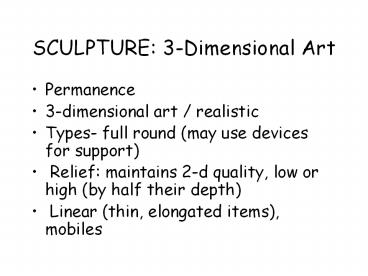SCULPTURE: 3-Dimensional Art - PowerPoint PPT Presentation
1 / 54
Title:
SCULPTURE: 3-Dimensional Art
Description:
SCULPTURE: 3-Dimensional Art Permanence 3-dimensional art / realistic Types- full round (may use devices for support) Relief: maintains 2-d quality, low or high (by ... – PowerPoint PPT presentation
Number of Views:458
Avg rating:3.0/5.0
Title: SCULPTURE: 3-Dimensional Art
1
SCULPTURE 3-Dimensional Art
- Permanence
- 3-dimensional art / realistic
- Types- full round (may use devices for support)
- Relief maintains 2-d quality, low or high (by
half their depth) - Linear (thin, elongated items), mobiles
2
(No Transcript)
3
(No Transcript)
4
(No Transcript)
5
(No Transcript)
6
(No Transcript)
7
(No Transcript)
8
(No Transcript)
9
Methods of Execution
- Subtraction (carving away)
- Material culture determines wood, stone, bone,
etc. - Types of rock (1) igneous (granite- hard,
lasting, difficult) - (2) Sedimentary (limestone- lasting, easy,
smooth, luster) - (3) Metamorphic (marble- lasting, pleasure to
carve, colors)
10
Methods Subtraction
- Creates a model, smaller than sculpture, of clay,
plaster, wax - Roughs out the image to within 2-3 inches of
finished area - Using a different set of tools, the sculptor
finishes the work to precise detail - Finally the sculptor polishes the material
11
(No Transcript)
12
(No Transcript)
13
(No Transcript)
14
Methods Construction
- Construction- adds element to element built
sculpture (plastics, metals, terracotta clay,
resins, wood, mixed media)
15
(No Transcript)
16
(No Transcript)
17
Methods Substitution
- Substitution- molded or cast
- Positive artist creates an identically sized
model - Negative covering the model with plaster, which
when hardens is removed, the sculptor has created
the negative mold for the sculpture - Sculptor pours molten metal into mold, the metal
hardens when cooled the sculpture emerges- it
can then be polished
18
Lost Wax Technique
- Lost wax technique (cire-perdue)- cast sculpture
in which the basic mold uses a wax model which is
then melted to leave desired spaces in the mold
19
Lost Wax
- 1. Sculptor covers core of clay in the shape of
the sculpture with wax layer - 2. He then carves details into the wax and
attaches rods pouring cup covers everything
with a thick layer of clay - 3. When the clay dries, the artist heats the mold
to melt the wax then pours molten metal into
the mold - 4. When metal solidifies, the mold is broken to
release the sculpture- it cannot be duplicated,
and is hollow, therefore lighter and less
expensive
20
(No Transcript)
21
(No Transcript)
22
(No Transcript)
23
Manipulation- modeling- clay
24
(No Transcript)
25
(No Transcript)
26
Sculptural Art Elements
- Mass (literal)
- Line Form open closed
- Space / Negative space
- Color
- Texture
27
Mass (Literal)
28
Open Form
29
Closed Form
30
Negative Space
31
Color
32
(No Transcript)
33
Texture
34
Texture
35
Texture
36
Design Principles
- Proportion, relative relationship of shapes to
one another - Scale- size in relation to standard
- Repetition (rhythm, harmony, variation)
- Balance - Biomorphic / geometric forms
- Articulation manner by which we move from one
element to the next (how the artist has repeated,
varied, harmonized, related its parts and the
movement from one part to another) - Focal area (emphasis)
37
Proportion- size of the parts in relation to the
whole
38
Scale size in relation to normal
39
Repetition
40
(No Transcript)
41
(No Transcript)
42
Balance
43
(No Transcript)
44
(No Transcript)
45
Contemporary Methods
- Found Objects changes the context of objects,
combines objects in a different way, or decides
an object has an aesthetic reference and presents
it that way - Ephemeral art conceptual, transitory, and makes
statement then ceases to exist
46
(No Transcript)
47
(No Transcript)
48
(No Transcript)
49
(No Transcript)
50
Ephemeral Art
51
(No Transcript)
52
(No Transcript)
53
(No Transcript)
54
Sensory Experience
- Touch
- Temperature
- Age
- Dynamics
- Size
- Lighting
- Environment































